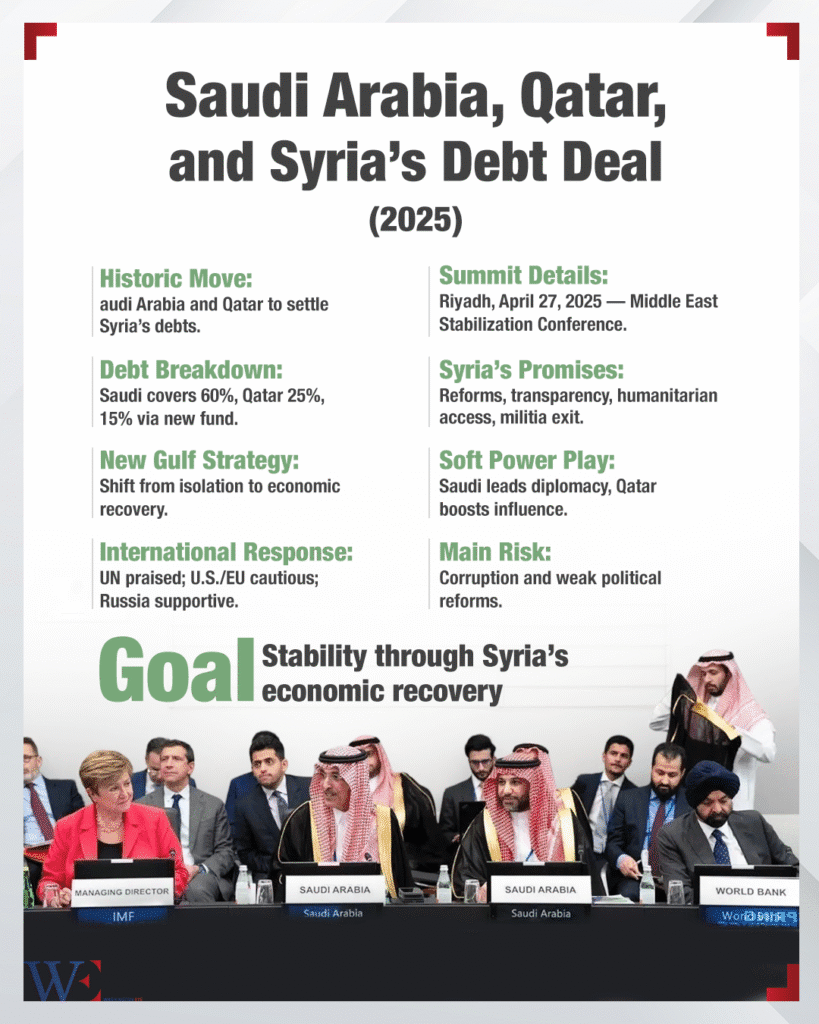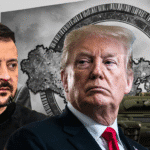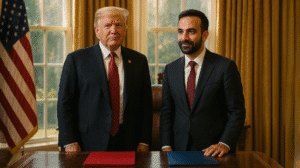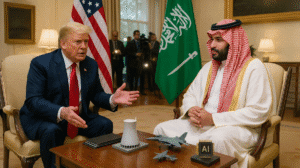In a historic move signaling a major shift in Middle Eastern diplomacy, Saudi Arabia and Qatar have jointly announced an initiative to settle Syria’s longstanding external debts. The announcement, made during a trilateral summit held in Riyadh on April 27, 2025, marks a significant step toward the financial and political rehabilitation of Syria after more than a decade of conflict and isolation.
Since the onset of the Syrian civil war in 2011, the country’s economy has been devastated. Widespread sanctions, infrastructure destruction, loss of human capital, and internal displacement contributed to Syria amassing a staggering amount of debt, both formal and informal, to foreign creditors. As of 2024, Syria owed billions of dollars to various countries and international institutions, most notably Iran, Russia, and China.
Following years of political rifts among Gulf nations and their diverging policies on Syria, the 2025 agreement between Saudi Arabia and Qatar reflects a broader regional effort to normalize relations with Damascus and reintegrate Syria into the Arab League and the broader international community. The agreement was signed on April 27, 2025, in Riyadh during a special Middle East Stabilization Conference attended by Gulf Cooperation Council (GCC) members, representatives from the Arab League, and observers from the European Union and United Nations.
The summit, initially aimed at enhancing cooperation on regional reconstruction projects, quickly evolved into high-stakes negotiations over Syria’s crippling debt. Sources close to the talks revealed that behind-the-scenes diplomatic efforts had been underway for months, spearheaded by Crown Prince Mohammed bin Salman of Saudi Arabia and Emir Sheikh Tamim bin Hamad Al Thani of Qatar.
Saudi Arabia will cover approximately 60% of Syria’s recognized external debts, particularly those owed to Gulf lenders and multilateral development banks while Qatar will assume responsibility for 25% of the debt, focusing primarily on humanitarian-related loans and reconstruction commitments. The remaining 15% will be managed through a newly established “Syrian Reconstruction Fund” backed by other regional partners and international donors. In exchange, Syria has agreed to enact economic reforms, promote national reconciliation, and work toward a UN-supervised political transition process. Specific conditions include transparency in financial transactions, assurances on humanitarian access, and a phased withdrawal of foreign militias from Syrian territory.
The settlement represents a pragmatic shift in Gulf strategy, recognizing that continued isolation of Syria has only prolonged instability in the region. By assuming part of Syria’s debt burden, Saudi Arabia and Qatar are betting on stability through economic recovery.
It also highlights the soft power competition in the Middle East: Saudi Arabia is keen to position itself as the region’s leading mediator, while Qatar continues its strategy of punching above its weight diplomatically.
For Syria, the deal is a lifeline. Although President Bashar al-Assad remains a controversial figure internationally, his government welcomed the move, with Syria’s Foreign Ministry calling it “an important step toward rebuilding Syria’s future on the foundations of peace, partnership, and prosperity.”
The United Nations praised the agreement as a “courageous initiative” and urged all parties to ensure that economic assistance is tied to human rights improvements and inclusive political dialogue. The United States and European Union cautiously welcomed the deal but emphasized that sanctions relief would depend on concrete political reforms inside Syria. Russia, a key Syrian ally, also voiced support, seeing the move as complementary to its own efforts to stabilize the country without having to foot the full bill for reconstruction.
While the agreement is groundbreaking, it is fraught with potential pitfalls. Ensuring transparency in the disbursement of funds will be a major concern, given Syria’s poor track record on corruption and governance. Furthermore, hardliners in the U.S. Congress and parts of Europe have warned against any normalization efforts that could be seen as rewarding authoritarian regimes without meaningful political change.
Moreover, within the region itself, not all Gulf states are fully on board. The United Arab Emirates, despite previously reestablishing diplomatic ties with Damascus, has signaled hesitation about providing direct financial aid without deeper assurances from the Assad government. The Saudi-Qatari agreement to settle Syria’s debt is a bold gamble aimed at reshaping the Middle East’s post-conflict landscape. It suggests a growing consensus among Arab states that economic incentives, rather than continued isolation, offer a better chance for lasting stability. Whether this gamble pays off will depend on the political will of Damascus and the sustained commitment of regional and international actors to a transparent, inclusive, and forward-looking recovery process. As Syria stands at a crossroads, the world watches closely — with cautious optimism.

















